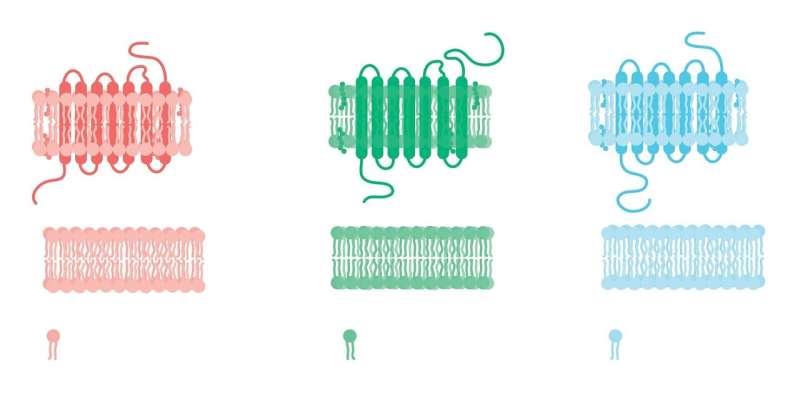
A study published in the journal Pharmacological Research describes the existence of a complex built by dopamine and noradrenergic receptors that could be a therapeutic target of potential interest to tackle the attention deficit hyperactivity disorder (ADHD) and impulsivity.
The paper, a preclinical study, has been carried out by the Research Group on Molecular Neuropharmacology, under the supervision of the lecturer Vicent Casadó, from the Faculty of Biology and the Institute of Biomedicine of the University of Barcelona (IBUB). Other participants are the National Institute on Drug Abuse of the National Institutes of Health (NIH) of the United States and the Institute of Investigation in Genetic engineering and Molecular Biology in Argentina.
α2AR-D4R complexes: beyond the monomeric model
The type 4 dopamine receptor gene (DRD4) presents different genetic polymorphisms that have been associated in the scientific bibliography with individual differences related to personality traits and neuropsychiatric disorders. The study describes a relation between the expression of the gene that codes the variant of the receptor of D4.7 dopamine and ADHD or the substance use disorders (SUD).
The results reveal an association between the gene encoding the α2A adrenoceptor and ADHD. Located in the pyramidal neurons of the prefrontal cortex, the α2A adrenoreceptors (α2AR) are the main pharmacological targets that facilitate the therapeutical effects of psychostimulants—such as methylphenidate or guanfacine—used in the treatment for ADHD.
The paper reveals these receptors are able to associate to form α2AR-D4R complexes or heteromers. This study hypothesis, confirmed by the results, was based on its association with impulsivity and ADHD, the simultaneous localization in cortical pyramidal neurons and the established ability of G protein-coupled receptors (GPCR) to form functional heteromers with each other.
The study, conducted in transfected cells and in transgenic laboratory animal models that express the human D4.7R receptor, explores the functionality of α2AR-D4R heteromers and its potential interest as a target to develop new therapeutical strategies that tackle the treatment for ADHD and impulsivity.
“We show that α2AR receptors can form oligomeric complexes with the most common polymorphism from the D4R receptor (D4.4R) and with the least common polymorphism (D4.7R), which has been correlated to the manifestation of ADHD,” says the researcher Verònica Casadó-Anguera, first author of the article.
The use of catecholamines—noradrenalin and dopamine, as well as synthetic drugs—in the research protocol has revealed the existence of differences in the affinity and signaling depending on the variant of the D4 receptor of dopamine that forms the heteromeric complex with the α2A receptors. Regarding the α2AR-D4.4R heteromer, both receptors can activate through dopamine and norepinephrine. However, within the α2AR-D4.7R heteromer, the D4.7R receptor cannot be activated by these catecholaminergic ligands nor D4R exogen ligands.
“The negative interaction we described between both receptors within the α2AR-D4.4R heteromer disappears when the D4.7R variant related to ADHD is involved”—continues Verónica Casadó-Anguera—”or when we disrupt the formation of heteromers with peptides from the transmembrane domain of the receptors involved in their interaction. This fact confirms the specificity of the observed effects.”
The α2AR-D4R heteromer could therefore be considered a molecular device that detects and responds to small variations in the concentration of endogenous catecholamines, the authors note.
“In short, the study shows that the negative interaction that is established physiologically between these two receptors—with a decisive role in controlling impulsivity and attention—does not occur when the individual expresses the ‘abnormal’ D4.7R polymorphism. This variant, which can also be associated with the α2AR adrenergic receptor, acts as a simple “stone guest,” but is unable to regulate it, a condition that leads to an excess of impulsivity,” explains Vicent Casadó.
A new perspective for designing future drugs
About 40% of the drugs that are marketed today are targeted at the wide group of proteins in the GPCR family, which are a key focus of biomedical research and new drug development programs.
However, despite the high presence of these drugs in the market, the therapeutic success of GPCR-targeted drugs is not total. “We consider that this is explained by the fact that most current strategies for drug development consider GPCRs as monomeric entities and do not take into account that GPCRs can be associated in heteromeric complexes,” says Vicent Casadó.
As the authors point out, the monomeric approach would lead to a component that is not always pharmacologically and functionally equivalent to the actual target, which are GPCR oligomers.
Source: Read Full Article


